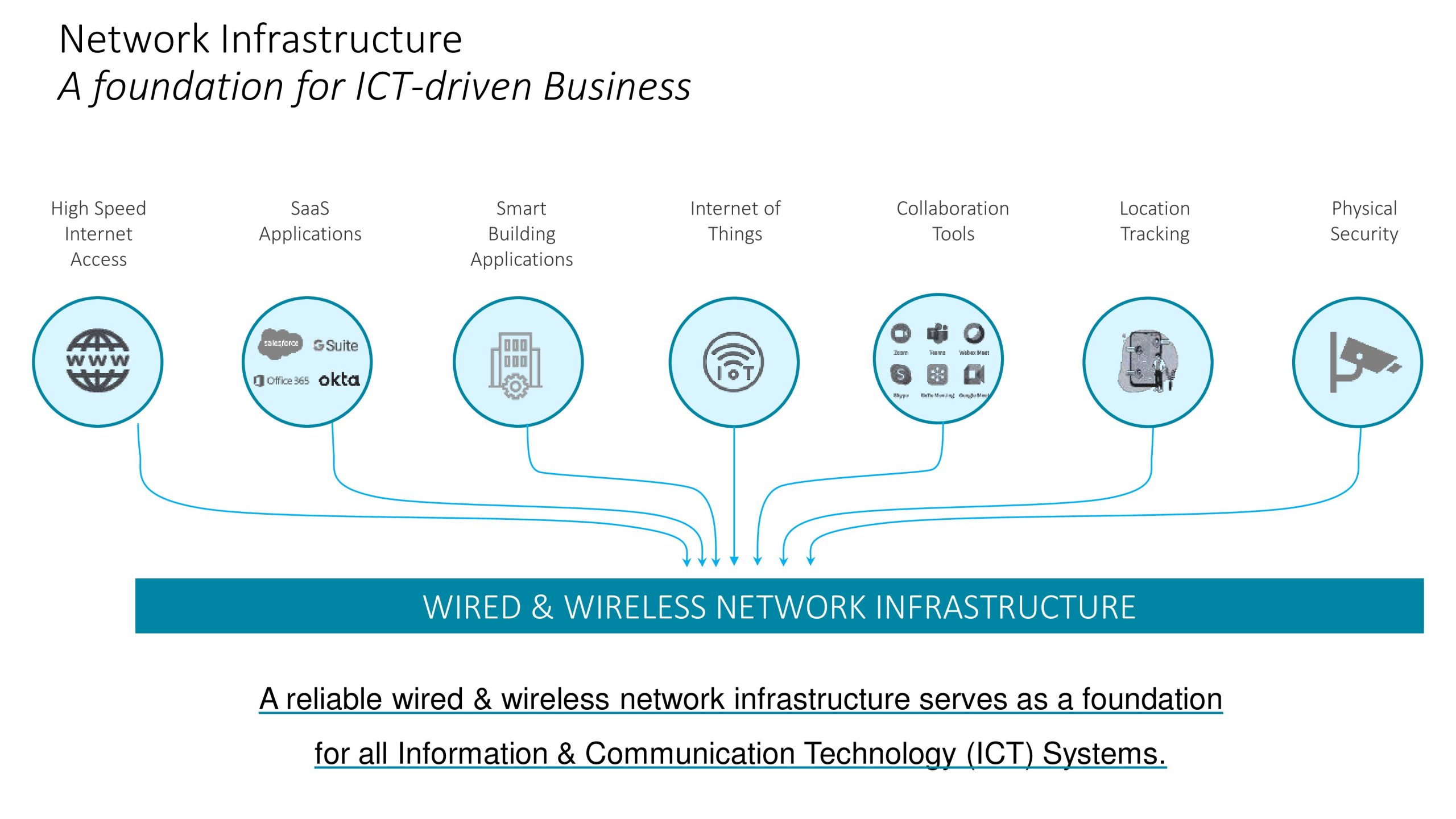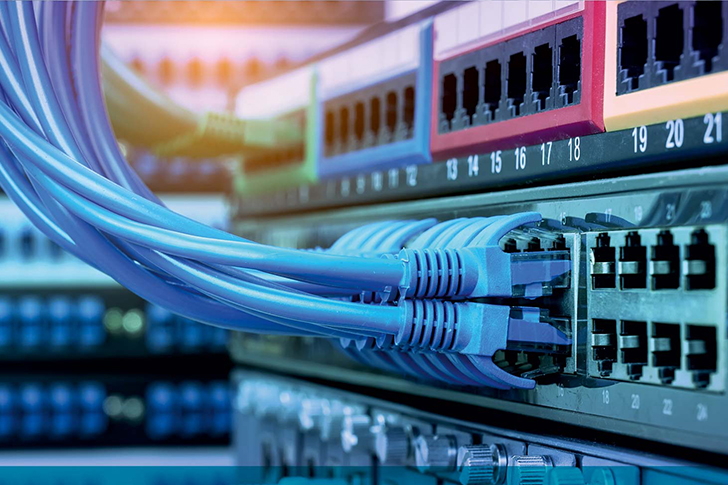Digital transformation is driving change across industries and businesses, bringing about a paradigm shift in business process along with customer experience. More and more devices are getting connected to the network, so there is massive increase in data generation resulting in ever-increasing demand for bandwidth. All this calls for a well-planned Structured Cabling Infrastructure that can enable technology transformation for – today, tomorrow and many years to come.
Emerging technology such as Cloud applications, IoT, WIFI 6/6E, multi gigabit support, Smart Building & Collaborative applications are network centric applications, that requires low latency network connections. Structured cabling has become one of the key foundations enabling applications to run smoothly and support business efficiency.
Emerging enterprise trends:
Post pandemic hybrid work model has become a reality with teams working from remote location and collaborating to create a unique experience. Collaborative & messaging tools such video communication platforms like ‘Zoom’, ‘Webex’ & ‘Teams’ are further aiding Hybrid-work culture. Another noteworthy trend is that most of the on-premises applications are moving to Cloud, with enterprises increasingly preferring cloud-based solution like Office 365, Salesforce etc. Likewise, HR, Payroll & Income tax returns are also being facilitated by cloud-based solution. So, there is an exponential rise in usage of cloud-based solution. Similarly, usage of IoT Applications is on a rise, as it helps to provide a Smart, Safe and Healthy work environment while saving a lot of energy costs. Overall – modernization of workplace is being accelerated by Digitization and so it’s imperative to have a connected network system that can embrace technology.
D-Link’s specific long range PoE switches support maximum 500-meter distance to power on PD devices like IP Camera with limited bandwidth.

Design considerations for Future-ready Horizontal Copper cabling design
When considering a new IT Infrastructure deployment or an upgrade of cabling Infrastructure, it is important to think beyond just cable
- The cabling design must be structured and future-ready to be able to scale with increasing business demands & technologies.
- New applications & devices have different bandwidth and different power requirement. And today these applications & devices can be categorized from Low bandwidth – Low Power to High Bandwidth – High Power.
- We are seeing agility in significant upgrades to the wired & wireless standards and innovating design consideration in switching, wireless & structured cabling solution.
When it comes to Structured Cabling Network Infrastructure, it is not easy to rip and replace the cables frequently. Structured cabling deployed today should support at least 2-3 generations of active components i.e., switches and wireless access points. So, we need to design & deploy cabling which is Future-ready.
For an efficient and connected structured cabling network, CAT 6A is highly recommended copper category cable. Cat 6A copper cables are designed to meet increasing business demands, while supporting modern technologies like Wi-Fi 6/6E, High Power PoE, IoT, Smart buildings and bandwidth from multi-Giga ~ 10G which will become the next speed for access with highest performance compared to previous categories like CAT 5e and CAT 6.
Cat 6A Solution recommended for Wi-Fi 6/6E
Wi-Fi 6 the latest standard in wireless is designed to improve speed, increase efficiency, and reduce congestion in heavy bandwidth usage scenarios. Wi-Fi 6 provides a completely different wireless user experience and supports maximum theoretical speed of 9.6Gbps. For users to harness maximum advantage of this latest technology it is recommended to use CAT 6A copper cable as a backhaul connectivity between AP and switch.
In today’s scenario more than 50% of the existing cabling is on CAT 5e or CAT 6. But using Cat 5e and Cat 6 option is a short-terms solution as replacing cables can be herculean task. Also, for those looking for superior performance from their Wi-Fi 6 network switching to Cat 6A will be imperative. Further another concern in using Cat 5e or Cat 6 for multi-gigabit applications is that they were designed for 1G Base-T applications and alien cross-talks was not considered at the time of designing cabling standards. So, the most effective cabling design solution for a trouble-free next generation BASE-T deployment is to utilize a shielded or isolated Category 6A solution, where alien crosstalk is specified, and the insertion loss allows for robust system operation in harsh environments.
Installing two Category 6A cables per AP provides optimal PoE performance, future proofing, design flexibility, and the potential through link aggregation.TSB-162-A Telecommunication cabling guidelines for wireless Access point recommends Cat 6A for horizontal cabling to connect APs in new installation in network.
Cat 6A Solution recommended for POE++
For enterprise campuses, Power over Ethernet (PoE) is convenient method for powering wireless access points (WAP), Cameras & IP Phones. The latest PoE standard is 802.3bt 4P PoE which has 2 new types – namely Type 3 & Type 4.
Type-3 supports up to 60W and Type-4 supports up to 100W, these are likely to expand the PoE ecosystem in enterprise. One of the application/devices which will benefit from this new 802.3bt PoE standard is Wi-Fi 6 Access Point which needs to support 1 or more multi gigabit port or 10G port, and high data throughput requires more power. However, on data side Cat 5E and Cat 6 can support multi gigabit, in some cases with shorter channel length and for short term.
When we use high power PoE on Cat 5e and Cat 6 cables it can generate more heat especially bundled cables, which increases the attenuation and reduces the channel performance. In some cases, it may damage the cable also if cable operating temp for existing installed cables are very less as it is designed without considering temp rise due to high power POE.
For any new installation, green field opportunities, recommended cabling is Category 6A either UTP or shielded with higher operating temp support and IEC certified connecting hardware for High Power PoE application.
Kindly follow (TIA) document, TSB-184-A, Guidelines for Supporting Power Delivery Over Balanced Twisted-Pair Cabling which provides guidance for installing cables that run POE++. TIA TSB-184-A raises requirement to Cat 6A to better support IEEE 802.3bt four pair POE.




